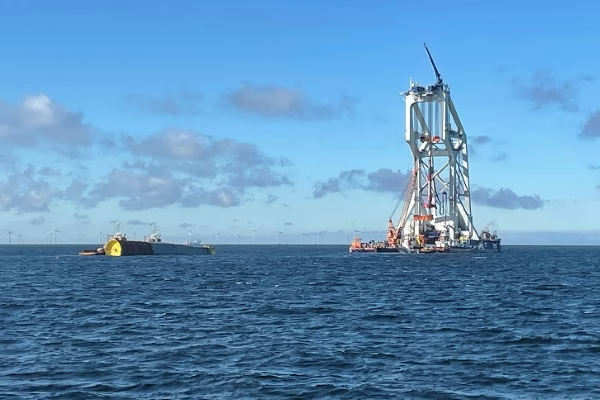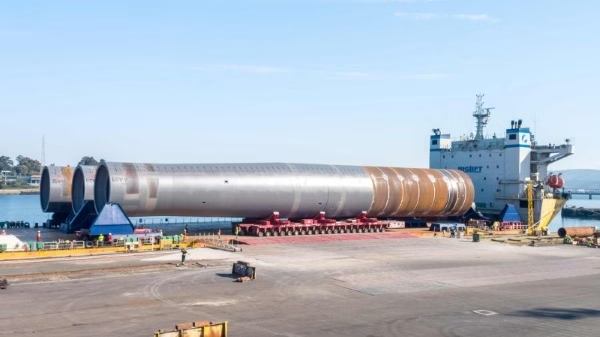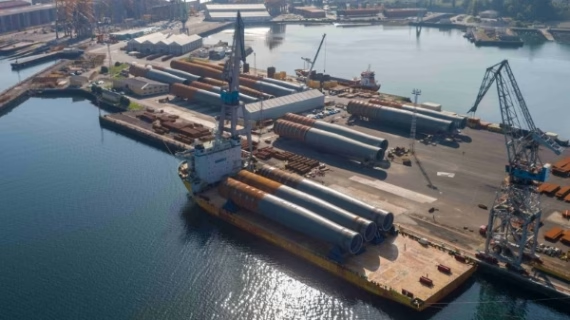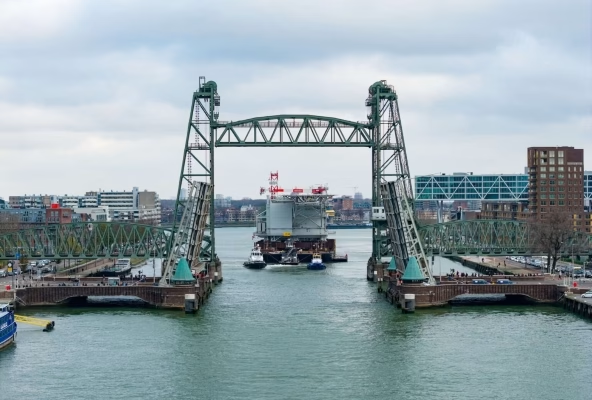Updated December 5, 2025 – Jasmund substation has departed the Netherlands and began transit to Windanker offshore wind farm site in the German Baltic Sea. Undertaking this is the HSI consortium comprised of HSM Offshore Energy, Smulders and Iv Group. The 4,500 ton Jasmund substation’s topside left HSM’s Stormpolder yard while its 72 meter tall jacket foundation sailed from Smulders’ Vlissingen facility. Offshore installation will be done by Heerema Marine Contractors. The milestone also marks Windanker’s transition from foundation work to grid connection as the offshore substation is important for the farm’s output link to the transmission system. Installation of the substation also means that Windanker is ready to enter its final installation phases ahead of commissioning in 2026. This is after Iberdrola also announced the installation of all Windanker’s monopile foundations in the Baltic Sea by contractor, Van Oord.

Windanker Offshore Wind Farm Construction Begins with First Monopile Installation
Reported October 2, 2025 – Construction of Iberdrola’s Windanker offshore wind farm in the Baltic Sea marks a milestone with the successful installation of the farm’s first monopile foundation. This milestone is a physical start of Iberdrola’s third large-scale offshore project in the region, following Wikinger and Baltic Eagle.
The monopiles, each measuring up to 84 meters in length and weighing approximately 2,100 tons, are being manufactured by Navantia, S.A., S.M.E and Windar Renovables in Spain. Installation is being done by marine contractor Van Oord, using its heavy-lift vessel, Svanen. This is one of the largest crane vessels in the world and is specifically equipped for foundation work in challenging offshore conditions. Van Oord’s new offshore installation vessel, Boreas, also recently finished first foundation installation at RWE’s 660 MW Nordseecluster A offshore wind farm in July 2025.

According to Felipe Montero, CEO of Iberdrola Germany, Windanker is both a technological and strategic investment:
“With Windanker, we are realizing the third major project of our Baltic Hub. The wind farm is not only a sustainable investment in the transformation of Germany, it also brings state-of-the-art offshore technology to the Baltic Sea, creates added value in the region and strengthens the link between German and Spanish industry.”
When complete, Iberdrola’s Windanker offshore wind farm in the Baltic Sea will deliver 315 MW of renewable electricity. This is equivalent to an average use of around 315,000 households.

Construction Gears on at Iberdrola’s 315 MW Windanker Offshore Wind Farm Project in the German Baltic Sea
Global energy player, Iberdrola, is developing its third offshore wind farm in the Baltics. The 315 MW Windanker wind farm lies off Germany’s shores. Construction of the wind farm started this summer and will end by 2026. Also pushing for Germany’s offshore renewable energy development is the Waterkant wind project that is currently working on its inter-array cable, and turbine supply.
In April 2025, Iberdrola also announced the final approval of its Windanker project by Germany’s Federal Maritime and Hydrographic Agency (BSH).
Project Factsheet
Location: Baltic Sea, Germany
Developer: Iberdrola
Partner: Kansai
Cost: €1.28 billion
Current phase: Construction
Turbine units: 21, SG 14-236 DD 15 MW turbines
Turbine supplier: Siemens Gamesa
Capacity: 315 MW
Other contractors: Windar
Start of construction date: Summer 2025
Operational date: Q4 2026
A look at Iberdrola’s 315 MW Windanker Offshore Wind Farm Project in Germany
Reported April 1, 2025 – With current offshore wind energy portfolio at 2,373 MW, Iberdrola plans to triple this number up to 6,500 MW by 2030. The 315 MW Windanker offshore wind project surely testifies to that. The latest federal go-ahead on the Windanker offshore wind project was the last planning approval stamp needed by the project whose development is already underway.
The new 315 MW Windanker wind farm in the German Baltic Sea will have 21 monopiloletes and other foundation infrastructure installed by Spanish-based Windar. This will be the first construction part of the project expected to start this summer. Upon completion of foundation installation, 21 Siemens Gamesa wind turbines each operating at 15 MW will then be installed. This will see Windanker wind project complete by the end of 2026. Once operational, the Windanker wind project in the German Baltic Sea will supply green energy to more than 300,000 homes.
This is also not the first offshore wind project Iberdrola and Kansai have partnered on. The duo also constructed the now operational 857 MW Triton Knoll that appears among the top ten largest offshore wind farms in the world as of 2025.
Iberdrola’s Play in Germany’s Green Energy Transition
Also driving German green energy transition will be other Iberdrola renewable energy projects. With German Baltic Sea wind projects like the 476 MW Baltic Eagle and the €1.4 bn Wikinger wind farm with a capacity of 350 MW, the three offshore wind projects will have a cumulative capacity of more than 1 GW possibly supplying the country’s electricity grid.
Iberdrola’s renewable energy portfolio in Germany is also undoubtedly not cheap. The three mentioned projects, termed the “Baltic Hub in the German Baltic Sea” by the CEO of Iberdrola Germany, Felipe Montero, will have so far cost close to €4 bn. However, this is not in vain as Germany’s electricity grid has around 882 MW of green energy. This is from a 1,388 GWh production capacity of renewable energy courtesy of Iberdrola.
As put by the renewable energy company, Iberdrola has been betting on clean energy for more than two decades. The company says this is not going to stop soon. Iberdrola has also already signed Power Purchase Agreements (PPAs) for the 315 MW Windanker offshore wind project in the German Baltic Sea.

